Manually Resolving Resource Overallocations
In this exercise and the next, you will continue to focus on resource allocation-how the task assignments you have made affect the workloads of the work resources (people and equipment) of the project. In this exercise, you will manually edit an assignment to resolve a resource overallocation. In the next exercise, you will automatically resolve resource overallocations.
Manually editing an assignment is just one way to resolve a resource overallocation. Other solutions include the following:
-
Replace the overallocated resource with another resource using the Replace button in the Assign Resources dialog box.
-
Reduce the value in the Units field in the Assignment Information or Assign Resources dialog box.
-
Assign an additional resource to the task so that both resources share the work.
If the overallocation is not too severe (such as assigning 10 hours of work in a normal eight-hour workday), you can often leave the overallocation in the schedule.
In this exercise, you will use the Resource Allocation view to examine one overallocated resource’s assignments and edit the assignment to eliminate the overallocation.
1. In the Resource Usage view in the upper pane, scroll vertically through the Resource Name column.
Note that several names appear in red. These are overallocated resources.
2. In the Resource Name column, click the plus sign next to the name of resource 14, Eric Lang, to display his assignments.
3. On the Standard toolbar, click Scroll To Task. ![]()
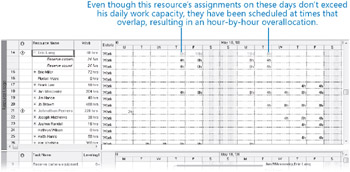
In the upper pane, you see that Eric is assigned full-time to two tasks that both start on Thursday, May 15. He is overallocated for the duration of both tasks. In the lower pane, you see the Gantt bars for the specific tasks that have caused Eric to be overallocated on these days. For tasks 9 and 10, Eric is assigned eight hours of work on each task Friday and Monday. This results in 16 hours of work per day, which is beyond Eric’s capacity to work.
You might also notice that Eric is assigned a total of eight hours of work on Thursday and then again on the following Tuesday. These values also appear in red, indicating that Eric is overallocated on those days as well. This is because the two tasks are scheduled to start at the same time on Thursday and end at the same time on Tuesday. Thus, even though Eric has a total of eight hours of work assigned on Thursday and Tuesday, he really has two four-hour assignments in parallel. This is an overallocation.
Next, you will manually resolve this overallocation by reducing the assignment units value.
4. In the Resource Name column, click Eric’s first assignment, Reserve camera equipment.
5. On the Standard toolbar, click the Assignment Information button. ![]()
The Assignment Information dialog box appears.
6. Click the General tab if it is not already visible.
7. In the Units box, type or click 50%, and then click OK to close the Assignment Information dialog box.
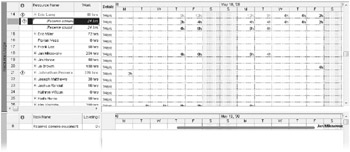
Eric’s daily work assignments on this task are reduced to two or four hours per day, but the task duration increased. You’d like to reduce the work but not extend the duration of the task. Note the Smart Tag indicator that appears next to the name of the assignment. You will use the Smart Tag to change the scheduling effect of the new assignment units.
8. Click the Smart Tag Actions button. ![]()
Look over the options on the list that appears.
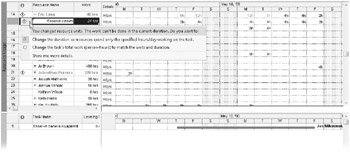
9. On the Smart Tag Actions list, click Change the task’s total work (person-hours) to match the units and duration.
Project reduces Eric’s work assignments on the task and restores the task to its original duration.
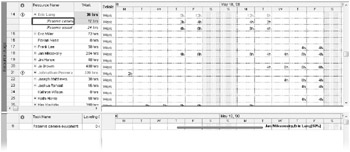
However, Eric is still overallocated. To remedy this, you will reduce his assignment units on the second task.
10. In the Resource Name column, click Eric’s second assignment, Reserve sound equipment.
11. On the Standard toolbar, click Assignment Information.
The Assignment Information dialog box appears.
12. Click the General tab if it is not already visible.
13. In the Units box, type or click 50%, and then click OK to close the Assignment Information dialog box.
14. Click Smart Tag Actions.
15. On the Smart Tag Actions list, click Change the task’s total work (person-hours) to match the units and duration.
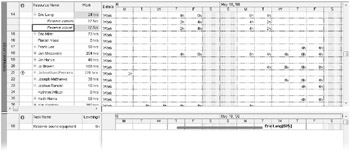
Eric’s total assignments on Friday and Monday are now reduced to eight hours each day. He is fully allocated on these days. By manually editing Eric’s assignments to reduce his work on these days, you have resolved his overallocation. However, the manner in which you resolved Eric’s overallocation was not the most direct method. You could also have edited his assignment values for Friday and Monday directly in the timescaled grid from eight to four hours each. The end result would have been the same.
Eric’s overallocation on tasks 9 and 10 is a good example of the type of problem automatic leveling (described in the following section) cannot resolve. Automatic leveling can do many things to a schedule, but it cannot change resource assignment units as you did here or change assignment work. You should apply your best judgment to determine where automatic leveling can help and where you may need to manually adjust the schedule to resolve overallocations.
Next, you will look at other resource overallocations in the short film project that you can resolve automatically with resource leveling.
EAN: 2147483647
Pages: 247